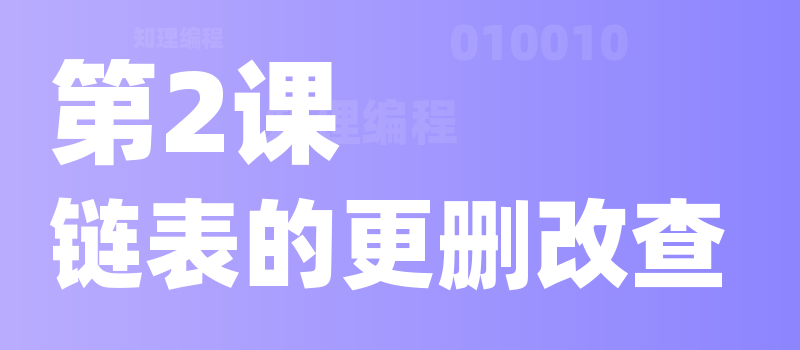第1课_什么是链表
热度🔥:36 免费课程
授课语音
什么是链表(Linked List)
一、链表介绍
链表(Linked List)是一种线性数据结构,由一组节点组成,每个节点包含数据元素和指向下一个节点的引用(或指针)。链表不同于数组,数组中的元素是按顺序存储在内存中的,而链表中的元素是分散存储的,每个元素通过指针连接。
1.1 链表的基本概念
链表是由一系列节点(Node)构成,每个节点包含:
- 数据域:存储数据。
- 指针域:指向下一个节点的引用。
链表的头节点(Head)是链表的入口,通常在操作链表时会通过头节点来遍历和操作链表。
1.2 链表的特点
- 动态大小:链表的大小可以根据需要动态增加或减少。
- 非连续存储:链表中的元素不是连续存储在内存中的。
- 插入和删除操作高效:在链表中插入或删除元素的时间复杂度是 O(1),只需要修改相关指针即可。
- 随机访问困难:与数组不同,链表不支持直接通过索引访问元素,查找元素需要从头节点开始逐个遍历。
1.3 链表的分类
- 单向链表(Singly Linked List):每个节点只包含指向下一个节点的指针。
- 双向链表(Doubly Linked List):每个节点包含指向前一个节点和后一个节点的指针。
- 循环链表(Circular Linked List):链表的尾节点指向头节点,形成一个环。
1.4 链表的优缺点
优点:
- 动态大小,内存利用率高。
- 在头部或中间插入、删除元素时,性能优越(O(1) 时间复杂度)。
缺点:
- 不支持随机访问,查找操作需要从头遍历。
- 每个节点需要额外存储指针,内存占用比数组大。
二、链表的基本操作
链表的常见操作包括:
- 插入:在链表的头部、尾部或中间插入新节点。
- 删除:删除链表中的指定节点。
- 查找:查找链表中的某个元素。
- 遍历:遍历链表中的所有节点。
- 反转:反转链表中的节点顺序。
三、链表的Java代码实现
下面是一个简单的单向链表的 Java 实现,并包含了常见操作的代码示例。
// 定义一个链表节点类
class ListNode {
int data; // 数据域,存储节点的值
ListNode next; // 指针域,指向下一个节点
// 构造函数
ListNode(int data) {
this.data = data;
this.next = null;
}
}
// 定义一个链表类
class LinkedList {
ListNode head; // 链表的头节点
// 构造函数
public LinkedList() {
this.head = null;
}
// 在链表头部插入节点
public void insertAtHead(int data) {
ListNode newNode = new ListNode(data); // 创建新节点
newNode.next = head; // 新节点的next指向当前头节点
head = newNode; // 更新头节点为新节点
}
// 在链表尾部插入节点
public void insertAtTail(int data) {
ListNode newNode = new ListNode(data); // 创建新节点
if (head == null) { // 如果链表为空,将新节点作为头节点
head = newNode;
} else {
ListNode current = head; // 从头节点开始遍历
while (current.next != null) { // 遍历到链表的最后一个节点
current = current.next;
}
current.next = newNode; // 将最后一个节点的next指向新节点
}
}
// 删除链表中指定值的节点
public void deleteNode(int value) {
if (head == null) return; // 链表为空,返回
// 如果删除的是头节点
if (head.data == value) {
head = head.next;
return;
}
ListNode current = head;
while (current.next != null && current.next.data != value) {
current = current.next; // 遍历链表,找到值为value的节点
}
if (current.next != null) { // 如果找到了节点
current.next = current.next.next; // 删除该节点
}
}
// 查找链表中是否存在某个值
public boolean contains(int value) {
ListNode current = head;
while (current != null) {
if (current.data == value) {
return true; // 找到节点,返回true
}
current = current.next;
}
return false; // 没有找到节点,返回false
}
// 打印链表的所有节点
public void printList() {
ListNode current = head;
while (current != null) {
System.out.print(current.data + " -> ");
current = current.next;
}
System.out.println("null"); // 链表结束
}
// 反转链表
public void reverse() {
ListNode prev = null;
ListNode current = head;
while (current != null) {
ListNode nextNode = current.next; // 保存下一个节点
current.next = prev; // 当前节点指向前一个节点
prev = current; // prev更新为当前节点
current = nextNode; // current移动到下一个节点
}
head = prev; // 更新头节点
}
}
// 测试链表操作
public class LinkedListDemo {
public static void main(String[] args) {
LinkedList list = new LinkedList();
// 插入节点
list.insertAtHead(1); // 头插法:插入1
list.insertAtHead(2); // 头插法:插入2
list.insertAtTail(3); // 尾插法:插入3
list.insertAtTail(4); // 尾插法:插入4
// 打印链表
System.out.println("链表内容:");
list.printList(); // 输出:2 -> 1 -> 3 -> 4 -> null
// 删除节点
list.deleteNode(1); // 删除值为1的节点
System.out.println("删除值为1后的链表:");
list.printList(); // 输出:2 -> 3 -> 4 -> null
// 查找节点
System.out.println("链表中是否包含值3:" + list.contains(3)); // 输出:true
System.out.println("链表中是否包含值1:" + list.contains(1)); // 输出:false
// 反转链表
list.reverse();
System.out.println("反转后的链表:");
list.printList(); // 输出:4 -> 3 -> 2 -> null
}
}
代码分析:
- ListNode类:定义链表节点的结构,包含一个整数数据域和一个指向下一个节点的指针(
next)。 - LinkedList类:定义链表的基本操作,包括插入、删除、查找、打印、反转等方法。
insertAtHead(int data):在链表头部插入一个新节点。insertAtTail(int data):在链表尾部插入一个新节点。deleteNode(int value):删除链表中指定值的节点。contains(int value):检查链表中是否存在指定值的节点。printList():打印链表中所有节点的值。reverse():反转链表。
- LinkedListDemo类:用于测试链表的各种操作。
四、总结
- 链表是一种动态数据结构,适用于需要频繁插入和删除操作的场景。
- 主要操作有插入、删除、查找、遍历、反转等。
- 链表相比数组的优点是高效的插入和删除,但缺点是需要额外的内存存储指针,且不支持随机访问。











